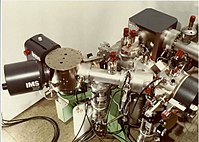
Photo from wikipedia
AbstractLipids are abundant biomolecules performing central roles to maintain proper functioning of cells and biological bodies. Due to their highly complex composition, it is critical to obtain information of lipid… Click to show full abstract
AbstractLipids are abundant biomolecules performing central roles to maintain proper functioning of cells and biological bodies. Due to their highly complex composition, it is critical to obtain information of lipid structures in order to identify particular lipids which are relevant for a biological process or metabolic pathway under study. Among currently available molecular identification techniques, MS/MS in secondary ion mass spectrometry (SIMS) imaging has been of high interest in the bioanalytical community as it allows visualization of intact molecules in biological samples as well as elucidation of their chemical structures. However, there have been few applications using SIMS and MS/MS owing to instrumental challenges for this capability. We performed MS and MS/MS imaging to study the lipid structures of Drosophila brain using the J105 and 40-keV Ar4000+ gas cluster ion source, with the novelty being the use of MS/MS SIMS analysis of intact lipids in the fly brain. Glycerophospholipids were identified by MS/MS profiling. MS/MS was also used to characterize diglyceride fragment ions and to identify them as triacylglyceride fragments. Moreover, MS/MS imaging offers a unique possibility for detailed elucidation of biomolecular distribution with high accuracy based on the ion images of its fragments. This is particularly useful in the presence of interferences which disturb the interpretation of biomolecular localization. Graphical abstractMS/MS was performed during time-of-flight secondary ion mass spectrometry (ToF-SIMS) analysis of Drosophila melongaster (fruit fly) to elucidate the structure and origin of different chemical species in the brain including a range of different phospholipid classes (PC, PI, PE) and di- and triacylglycerides (DAG & TAG) species where reference MS/MS spectra provided a potential means of discriminating between the isobaric [M-OH]+ ion of DAGs and the [M-RCO]+ ion of TAGs.
Journal Title: Analytical and Bioanalytical Chemistry
Year Published: 2017
Link to full text (if available)
Share on Social Media: Sign Up to like & get
recommendations!